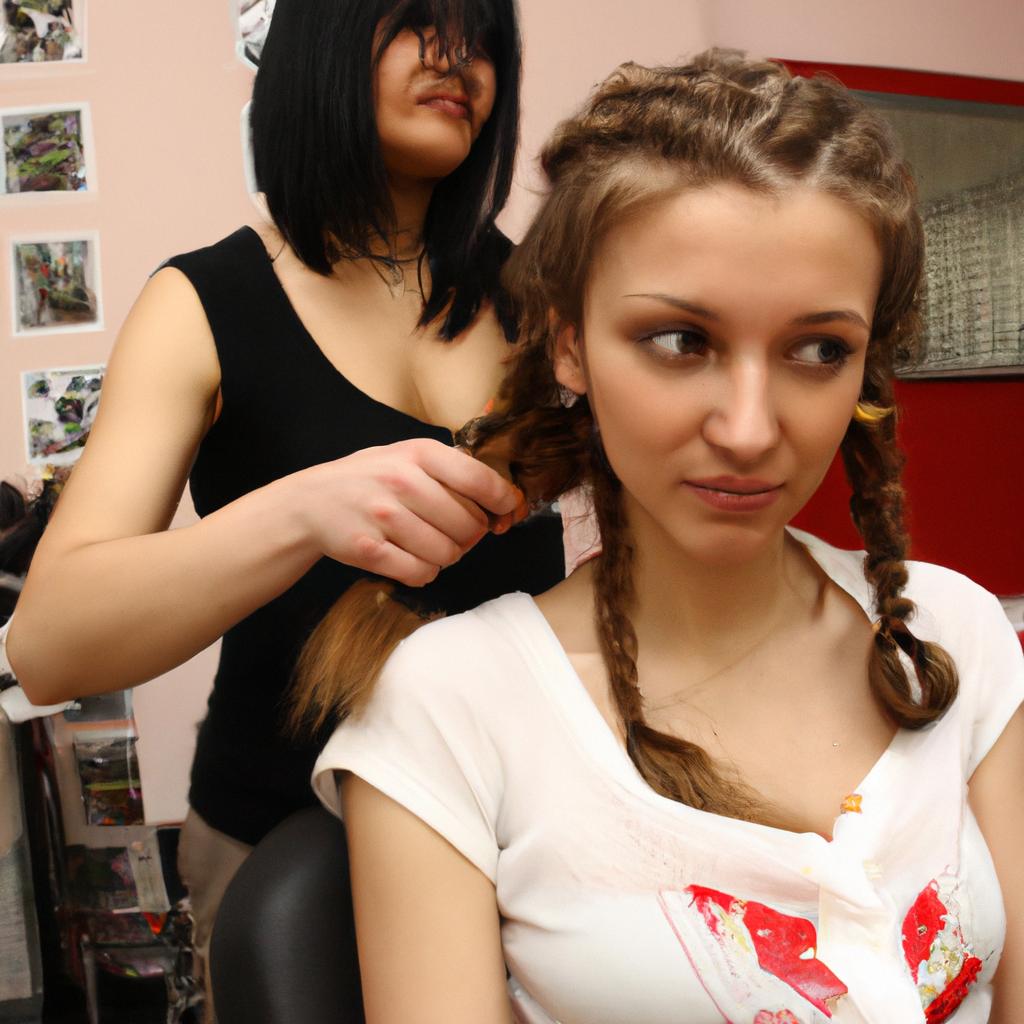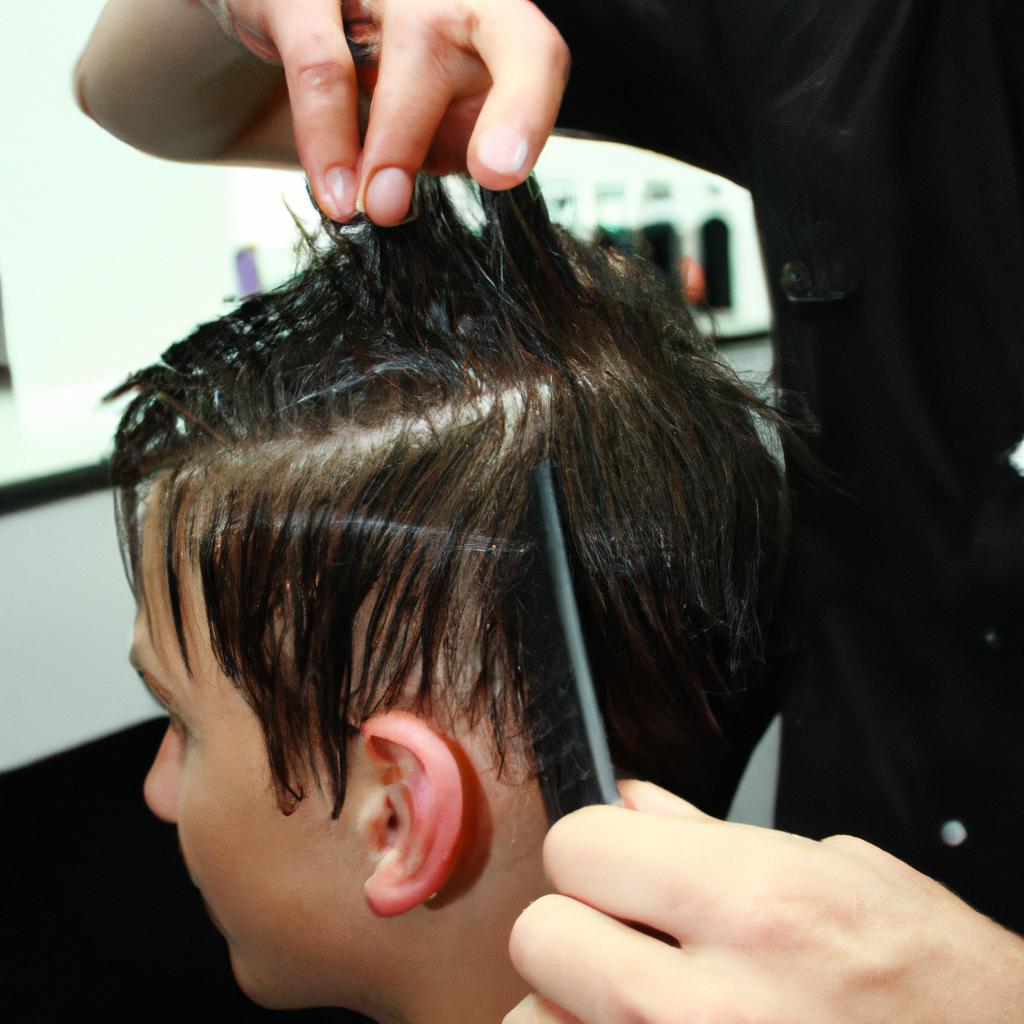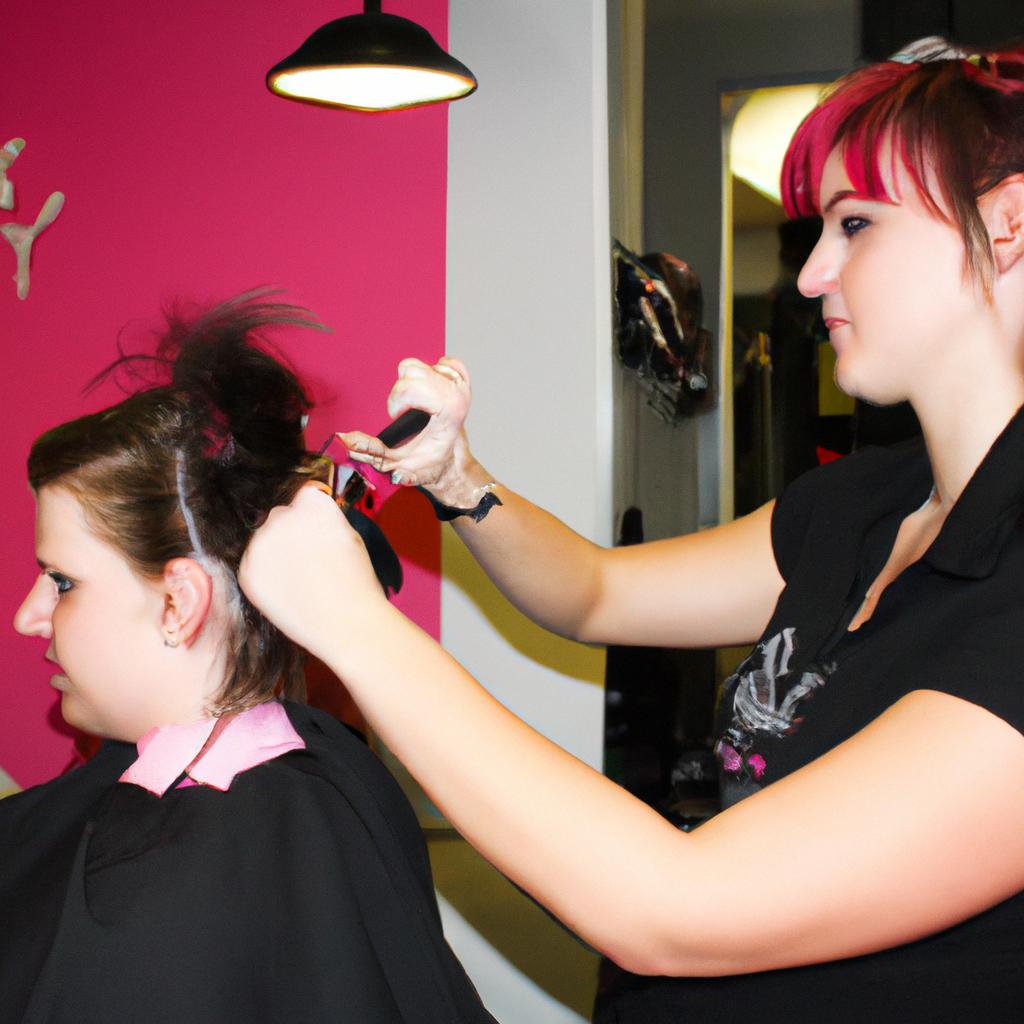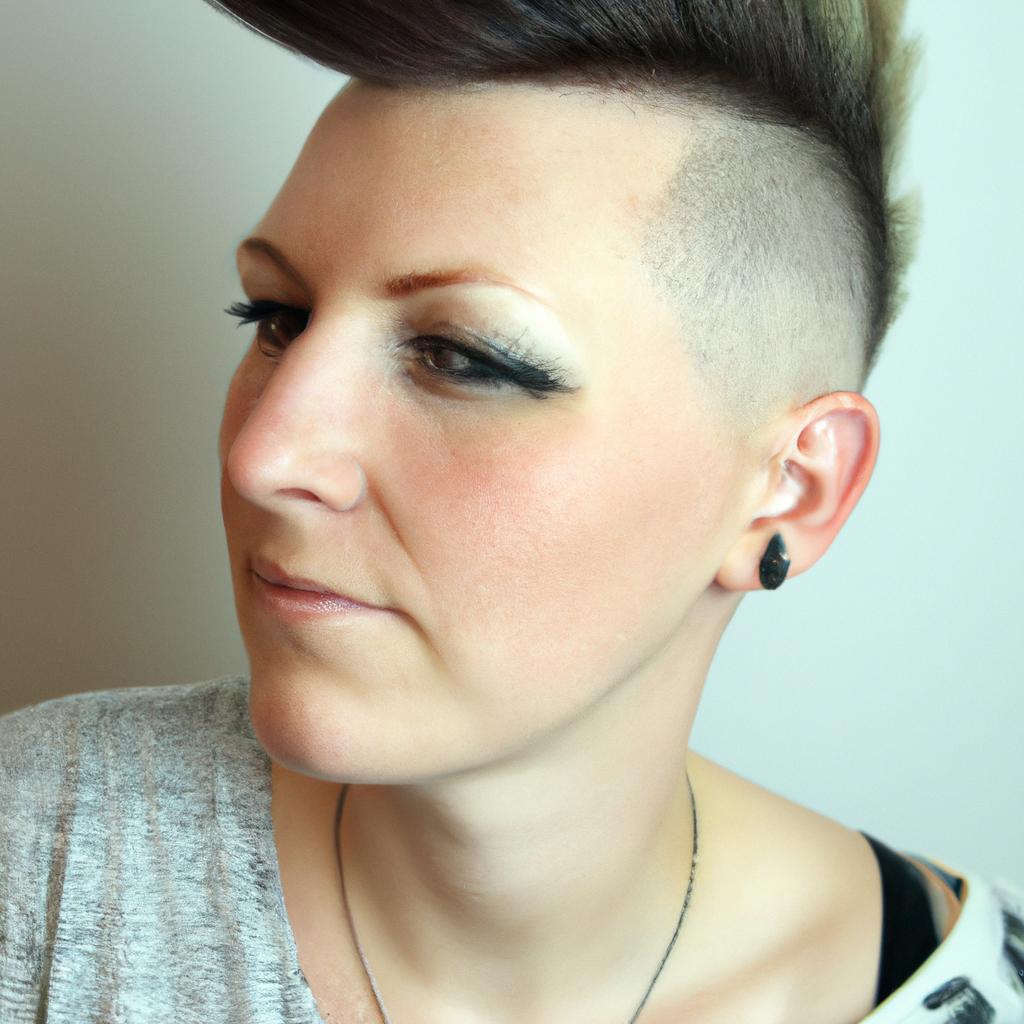Braided haircuts have long been a popular choice for individuals seeking to add creativity and uniqueness to their hairstyles. Whether it be intricate cornrows or elegant French braids, these styles offer versatility and aesthetic appeal. This article aims to provide a comprehensive guide for hairstylists working in hairdressing salons, equipping them with the necessary knowledge and techniques required to master the art of braided haircuts.
In recent years, there has been a resurgence in the popularity of braided haircuts among people from diverse backgrounds. For instance, consider Sarah, a young professional who recently visited her local hairdressing salon seeking a hairstyle that would reflect her vibrant personality while still maintaining professionalism at her workplace. After discussing various options with her stylist, Sarah decided on an exquisite fishtail braid that perfectly complemented her features and met her requirements. Such examples emphasize the importance of understanding different types of braids and having the requisite skills to execute them flawlessly.
This article will delve into various aspects related to braided haircuts including their historical significance, cultural relevance in different societies, as well as step-by-step instructions on how to achieve different types of braids. By following this guide closely, hairstylists can enhance their expertise in creating stunning braided hairstyles that cater to the unique preferences and needs of their clients.
To begin, it is crucial to understand the historical significance of braids. Braiding dates back thousands of years and has been practiced by various cultures around the world. From ancient Egypt to Native American tribes, braids have served as a symbol of cultural identity, social status, and even religious beliefs. By appreciating the rich history behind braided hairstyles, hairstylists can better connect with their clients and create meaningful looks that pay homage to these traditions.
Next, it is important to explore the cultural relevance of braided haircuts in different societies. For example, in African culture, intricate cornrows are often worn as a way to express creativity and celebrate heritage. On the other hand, French braids are commonly associated with elegance and grace in Western societies. By understanding these cultural nuances, hairstylists can suggest appropriate braided hairstyles that align with their clients’ values and desired aesthetics.
Now let’s dive into step-by-step instructions on how to achieve different types of braids. It is essential to start with clean, detangled hair before beginning any braid. For beginners or those looking for a simple yet stylish look, a classic three-strand braid is a great option. Divide the hair into three sections and cross them over one another until reaching the end. Secure with an elastic band for a polished finish.
For more intricate styles like Dutch braids or fishtail braids, additional techniques are required. Dutch braids involve crossing strands under one another instead of over, creating a raised effect on top of the head. Fishtail braids require dividing the hair into two sections and taking small pieces from each side alternately until reaching the ends.
Experimenting with different variations such as waterfall braids or crown braids can add further versatility to your repertoire as a hairstylist. These styles involve incorporating loose strands or braids into the main braid, resulting in a whimsical and romantic look.
Remember to finish off each braid with an appropriate styling product, such as hairspray or serum, to ensure longevity and hold. Additionally, encourage your clients to maintain their braided hairstyles by gently detangling and moisturizing the hair regularly.
In conclusion, mastering the art of braided haircuts requires knowledge of different types of braids, appreciation for their historical significance and cultural relevance, as well as practice in executing various techniques. By following this comprehensive guide, hairstylists can confidently create stunning braided hairstyles that reflect their clients’ individuality and leave them feeling empowered and beautiful.
Benefits of Braided Hairstyles
Benefits of Braided Hairstyles
One example that showcases the benefits of braided hairstyles is Sarah, a busy professional who found herself struggling with managing her long hair. She often spent hours each morning styling and taming her unruly locks. One day, she decided to try a braided haircut as an alternative solution. Not only did it save her time in the mornings, but she also noticed several other advantages.
Firstly, braided hairstyles offer versatility. With various types of braids available like French braids, fishtail braids, or cornrows, individuals can choose a style that suits their preferences and occasions. This flexibility allows people to experiment with different looks and express their personal style effortlessly.
Secondly, braided hairstyles are low-maintenance. Once properly done by a skilled hairdresser at a reputable salon, they require minimal upkeep compared to traditional haircuts. The intricate weaving technique used in these styles ensures longevity without frequent touch-ups or restyling needed.
Furthermore, many people find comfort in wearing braided hairstyles due to their protective nature. Braids help shield the hair from external elements such as heat damage caused by styling tools or harsh weather conditions like sun exposure or extreme temperatures. Additionally, this type of hairstyle prevents excessive tangling and breakage that often occurs when leaving hair loose.
- Boosts confidence: By sporting unique and stylish braid designs, individuals feel more self-assured and ready to take on any challenges.
- Enhances natural beauty: Braids amplify facial features while showcasing one’s natural hair texture.
- Reduces daily stress: With less time required for hairstyling each day, individuals experience reduced stress levels during their morning routine.
- Promotes healthy hair growth: Braiding helps protect fragile ends from splitting and promotes overall hair health.
In addition to evoking an emotional response, the benefits of braided hairstyles can be summarized in a table format:
| Benefit | Description |
|---|---|
| Versatility | Choose from various braid styles to suit personal preferences and occasions. |
| Low-maintenance | Long-lasting style that requires minimal touch-ups or restyling. |
| Protective nature | Shields hair from external elements and prevents tangling or breakage. |
In conclusion, braided hairstyles offer numerous advantages such as versatility, low maintenance, protection, and improved hair health. These benefits not only save time but also enhance one’s appearance while reducing daily stress levels associated with hairstyling. Next, we will explore different types of braided haircuts.
Moving on to the subsequent section about “Different Types of Braided Haircuts,” let’s delve into the diverse range of options available for individuals seeking unique styles that suit their specific needs and preferences.
Different Types of Braided Haircuts
After exploring the various benefits of braided hairstyles, let us now delve into the different types of braided haircuts that are available in hairdressing salons. Understanding these variations will help you choose a style that suits your preferences and enhances your overall look.
Types of Braided Haircuts
-
French Braids: French braids are one of the most popular and timeless braided hairstyles. They involve weaving three strands of hair together from the crown down to the nape of the neck, creating an elegant and polished look. This classic style is versatile and can be worn for both casual and formal occasions.
-
Fishtail Braids: If you prefer a more intricate and eye-catching hairstyle, fishtail braids might be perfect for you. These braids create a unique pattern by intertwining small sections of hair, resembling the scales of a fish’s tail. Fishtail braids give off an effortlessly chic vibe and work well with tousled or messy looks.
-
Dutch Braids: Dutch braids, also known as inverted or reverse French braids, add depth and texture to your hairdo. Unlike traditional French braids where each section goes over the middle strand, Dutch braids involve crossing each section underneath instead. The result is a braid that appears raised from the scalp, giving it a more voluminous appearance.
-
Box Braids: For those seeking a protective hairstyle that requires minimal maintenance, box braids offer both functionality and trendy appeal. These individual plaits are created by adding synthetic or natural hair extensions to your own tresses, resulting in sleek and long-lasting styles that can be easily customized to suit your desired length and thickness.
- Enhances hairstyling versatility
- Provides protection for natural hair
- Adds visual interest to any outfit
- Can last for several weeks with proper care
Markdown table:
| Type of Braided Hairstyle | Description |
|---|---|
| French Braids | Classic and elegant style. |
| Fishtail Braids | Intricate and eye-catching design. |
| Dutch Braids | Voluminous braids with raised appearance. |
| Box Braids | Protective style that can be customized. |
By understanding the various types of braided haircuts, you will have a clearer idea of which style appeals to you the most. In the subsequent section, we will guide you through choosing the right braided hairstyle for your needs, ensuring a look that complements your individuality and enhances your overall beauty.
Choosing the Right Braided Hairstyle for You
Imagine this scenario: Sarah, a young professional with long and thick hair, decides to get a braided haircut for the first time. Excited about her new look, she walks into a hairdressing salon and discusses her options with the hairstylist. As they delve deeper into the conversation, it becomes evident that Sarah is unaware of the maintenance requirements associated with braided hairstyles. In order to ensure that every individual makes an informed decision regarding their hairstyle choices, it is essential to understand the upkeep involved in maintaining braided haircuts.
To begin with, it is important to recognize that different types of braided haircuts require varying levels of care. While some styles may only demand minimal attention, others necessitate regular maintenance routines. For instance, microbraids—a popular choice among individuals seeking versatility—typically call for meticulous washing and conditioning at least once a week to prevent buildup and maintain scalp health. On the other hand, box braids are known for their durability but can become frizzy if not properly maintained through routine moisturizing treatments.
In addition to regular cleansing and hydrating practices, keeping your braided hairstyle intact also requires careful handling and protection during sleep or physical activities. It is recommended to wrap your hair in a silk scarf or wear a satin bonnet before going to bed as these materials minimize friction and reduce breakage caused by rubbing against cotton pillowcases. Similarly, when engaging in sports or exercise, tying your braids up in a ponytail or bun will help prevent them from becoming tangled or damaged.
Understanding the maintenance requirements of braided haircuts leads us on an emotional journey—one filled with dedication and self-care—as we strive to keep our chosen style looking fresh and vibrant. Consider these key points:
- Regular washing and conditioning rituals contribute to healthier strands.
- Moisturizing treatments help combat dryness and maintain overall braid quality.
- Protective measures, such as using silk or satin accessories, safeguard the hair from external damage.
- Proper styling techniques minimize breakage and preserve the longevity of the braids.
By adopting these maintenance practices, individuals can enhance their overall hairstyling experience while reveling in the beauty and uniqueness that comes with braided haircuts. As we move forward, let us now explore how to prepare for a braided haircut and ensure an optimal outcome.
How to Prepare for a Braided Haircut
Transitioning seamlessly from the previous section on choosing the right braided hairstyle for you, let’s now explore how to prepare for a braided haircut. To illustrate this process, consider the case of Sarah, who recently decided to get a braided haircut and wants to ensure she is properly prepared.
Firstly, it is essential for Sarah to communicate her desired braided style clearly to her hairdresser. This can be achieved by bringing reference images or discussing specific details such as braid size, pattern, and placement. By doing so, Sarah ensures that both she and her hairdresser are on the same page regarding expectations and outcomes.
Secondly, Sarah should take proper care of her hair before getting a braided haircut. This involves washing and conditioning her hair thoroughly to remove any product buildup or dirt that may hinder the styling process. Additionally, moisturizing the scalp with natural oils helps maintain healthy locks throughout the braiding procedure.
Thirdly, Sarah can consider using protective products prior to her appointment. These products help strengthen the hair strands and protect them against potential damage caused by tension during braiding. It is advisable for Sarah to consult with her hairstylist about which products would be most suitable for her particular hair type.
In addition to these preparation steps, it is important for individuals considering a braided haircut to understand the emotional impact it may have on them. Here are some key points to keep in mind:
- Braids can enhance self-confidence by providing a stylish and unique look.
- The act of having someone else artfully weave your hair can be relaxing and therapeutic.
- Experimenting with different braid designs allows individuals to express their creativity.
- Braids offer convenience by reducing daily maintenance routines and minimizing exposure to damaging elements like heat styling tools.
| Emotion | Associated Benefits |
|---|---|
| Excitement | Enhanced self-expression and personal style |
| Relaxation | Therapeutic experience and reduced stress |
| Creativity | Outlet for artistic expression |
| Convenience | Simplified hair care routine |
By understanding the emotional impact of braided haircuts, individuals like Sarah can better prepare themselves both mentally and physically before stepping into the salon. With these insights in mind, let’s now explore maintenance tips for braided haircuts.
Now that we have covered how to properly prepare for a braided haircut, let’s shift our focus towards maintaining your new hairstyle with some helpful tips.
Maintenance Tips for Braided Haircuts
Once you have gotten your perfect braided haircut, it is crucial to maintain its freshness and longevity. Proper maintenance ensures that your hair remains healthy, tangle-free, and stylish throughout the duration of your chosen braided hairstyle. By following these maintenance tips, you can keep your braids looking flawless.
To begin with, regular washing is essential to remove dirt build-up and prevent scalp irritation. Use a sulfate-free shampoo and gently massage it into your scalp while avoiding excessive pulling or rubbing of the braids. Rinse thoroughly with lukewarm water to ensure all product residue is removed. After washing, pat dry your braids using a soft towel or allow them to air dry naturally.
In addition to washing, applying a leave-in conditioner will help keep your hair moisturized and reduce frizz. Simply spray or apply a small amount of leave-in conditioner onto your hands, then carefully distribute it throughout the length of your braids. This step not only keeps your hair hydrated but also adds shine and flexibility.
Moreover, regularly oiling your scalp is vital in preventing itchiness and maintaining overall hair health. Using natural oils such as coconut oil or jojoba oil, gently massage the oil onto your scalp at least once a week. This practice improves blood circulation and nourishes both your scalp and hair follicles from within.
Lastly, protect your braids during sleep by wrapping them with a satin scarf or using a satin pillowcase. Satin helps minimize friction between the fabric and the braid surface, reducing breakage and preserving the neatness of the style overnight.
Remember:
- Avoid excessive manipulation or constant touching of the braids.
- Minimize exposure to extreme heat sources like blow dryers or curling irons.
- Trim any loose ends periodically to maintain tidiness.
- Schedule regular touch-ups with a professional stylist to ensure proper maintenance.
| Hair Maintenance Tips |
|---|
| Wash regularly with a sulfate-free shampoo. |
Incorporating these maintenance practices into your hair care routine will help prolong the life of your braided haircut, keeping it fresh and stylish for longer periods.
Now that you are familiar with the essential tips on maintaining your braided hairstyle, let’s delve into the world of famous celebrities who confidently rock their own unique braided looks.
Famous Celebrities Who Rock Braided Haircuts
Moving on from maintenance tips, let’s now explore the versatility of braided haircuts. These trendy hairstyles offer endless possibilities for individuals looking to experiment with their appearance and express their personal style.
Braided haircuts provide a wide range of options that can be tailored to suit various occasions and preferences. For instance, imagine attending a formal event where you want to exude elegance and sophistication. A classic French braid cascading down your back would effortlessly achieve this desired look, complementing an evening gown or cocktail dress. On the other hand, if you’re aiming for a more casual vibe, consider opting for a messy fishtail braid paired with jeans and a t-shirt – it adds an effortless touch while still maintaining a stylish appeal.
To further illustrate the versatility of braided haircuts, here are some popular styles worth exploring:
- Box Braids: This protective hairstyle involves adding extensions to create individual braids that hang freely. It offers flexibility in length, thickness, and color variations.
- Cornrows: These tightly woven braids close to the scalp are perfect for those seeking low-maintenance styling options. They can be arranged into intricate patterns or simple rows depending on preference.
- Dutch Braid: Also known as an inverted French braid, this technique creates an eye-catching three-dimensional effect by weaving strands under rather than over each other.
- Waterfall Braid: This romantic style involves dropping sections of hair as you weave them through the braid, creating the illusion of flowing locks.
Additionally, considering celebrities who have embraced these stunning hairstyles helps emphasize their popularity and adaptability across different cultures and industries. The table below showcases four notable figures who have confidently rocked various braided haircuts:
| Celebrities | Signature Braided Hairstyle |
|---|---|
| Beyoncé | Lemonade-inspired Braids |
| Zendaya | Fulani-inspired Braids |
| Alicia Keys | Box Braids |
| Lupita Nyong’o | Crown Braid |
It is clear that braided haircuts offer a diverse range of styles suitable for any occasion. Whether you prefer an intricate updo or a more relaxed bohemian look, there is undoubtedly a braided hairstyle that will perfectly complement your individuality and desired aesthetic.
Through their versatility and the ability to showcase personal style, braided haircuts have become increasingly popular in recent years. So why not take the plunge and embrace this timeless trend, confident in the knowledge that you can effortlessly switch between various stunning looks with ease? Explore these hairstyles further and discover which one resonates most with your unique personality and fashion sense.




